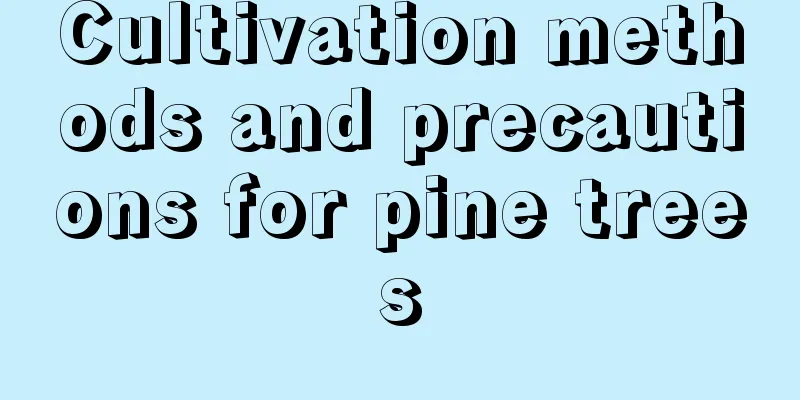Cultivation methods and precautions for pine trees

1. Maintenance methods1. Substrate selection: It has no strict requirements on soil, has strong adaptability, and can tolerate barrenness. It is best to choose loose, fertile, well-drained, slightly acidic sandy loam. 2. Light management: Most of them like light and have weak shade tolerance. If they are kept in a dark environment for a long time, it will easily lead to a sparse crown. Therefore, when cultivating them, they should be given sufficient sunlight as much as possible to facilitate their healthy growth. 3. Water management: Its leaves are narrow and the cuticle is well developed, with a xerophytic structure, so it is drought-resistant and can endure water shortage without being harmed. It can grow in arid environments with shallow soil and many rocks. Excessive water content in the soil is not conducive to its growth. Attention should be paid to drainage to avoid waterlogging. 4. Temperature management: It is a famous pioneer tree species with strong adaptability to environmental temperature. It is cold-resistant and heat-resistant, and can thrive in both high and low temperature environments. 2. Breeding techniques1. Reproduction method: It can be propagated by sowing or cutting. Among them, the sowing method is to store the seeds in the sand in winter to germinate, cover the sand pile with straw mats, pay attention to keeping warm and preventing frost, and keep the environment ventilated. When about half of the seeds have cracks in the next year, they can be sown. 2. Transplantation method: The transplantation method varies depending on the type of seedlings. Container seedlings have a higher survival rate because they are covered with soil, which can protect the roots of the plants from being damaged during the transplantation process. The roots of bare-root seedlings are relatively easily damaged, so you need to pay attention to protecting the roots during transplantation. 3. Problem diagnosis and treatment1. Yellowing leaves: If the needles turn yellow due to water loss, be sure to check whether there are signs of longhorn beetle parasitism. Once discovered, the diseased trees must be manually cut down and removed in time to prevent the longhorn beetles from spreading and harming the trees. 2. Pests: The more common pests include red spider mites, large bagworm moths, red wax scale insects, etc. Once found, they should be sprayed with insecticides in time. IV. Other issues1. Meaning: The tree has a vigorous and majestic posture, a tall and long-lived shape, and a long history and culture. It is regarded as a symbol of firmness, chastity, and longevity. Together with plum and bamboo, it is known as the "Three Friends of Winter". It has the tenacity to overcome adversity and difficulties. 2. Toxicity: It is non-toxic. Pine wood is generally used as industrial raw material. The pine resin can be used to extract rosin. The seeds and pine needles of some varieties can also be used as medicine, which is of great practical value. |
<<: Cultivation methods and precautions of Tia
>>: Planet breeding methods and precautions
Recommend
How to water petunias
Petunia Watering Tips Like most plants, when wate...
What are the requirements for soil for growing orchids? Can orchids be grown with soil?
1. What are the requirements for soil for growing...
To repot an old succulent plant, you only need a pair of tweezers and a brush, and the stem will grow longer and stronger!
Repotting old succulent plants like this will mak...
How to disinfect cutting medium
High temperature sterilization of cutting medium ...
Maintenance methods of chicken shit vine
1. The habit of this plant First of all, it requi...
The efficacy and function of hand ginseng
Efficacy and function This plant has high medicin...
What fertilizer is best for cyclamen?
1. By element Before choosing fertilizer for it, ...
How does Begonia spend the winter?
How does Begonia spend the winter? The growth hab...
What to do if Monstera grows too tall
What does Monstera look like when it grows too lo...
Can Wisteria be potted?
Can Wisteria be potted? Wisteria can be planted i...
Put the foam board on the basin, flush it with water, and all the bugs will die!
Foam board basin cover If flowers are infected wi...
When is the best season to plant jasmine?
Jasmine planting season and time The cultivation ...
Planting methods and techniques of Sunshine Rose grapes
Sunshine Rose Grape is a new grape variety, also ...
What flowers are suitable for growing in Gannan? What are the city flowers and trees?
1. Climate characteristics of Gannan Gannan's...
What is the best month to plant carrots?
When to plant carrots Carrots are generally plant...









